Contents
Regular pruning of apricots is one of the important and necessary conditions for a good harvest. Apricot bears fruit on fruit formations and branches of the previous year. Over time, the growth processes of the tree slow down. As a result, adult large branches, after fruiting, are exposed. Therefore, you should form the crown of a tree and know how to properly cut an apricot, supporting growth processes in which the length of the annual growth will be at least 35-45 cm.
Trimming time
The main feature of the apricot is that it does not shed the ovaries on its own, as a result, the tree is constantly overloaded with a large amount of crop, since most of the flowers form into fruits. In order for the tree to remain in good condition, the fruits were large, apricot trees are pruned, depending on the goals and possibilities, at different periods – in spring, summer or autumn. The video tells the advantages and disadvantages of cutting apricots at different times.
Autumn pruning
In October, only medium or early varieties are pruned. Also in the autumn, it is advisable to rejuvenate the tree – removing old, already bare branches and other perennial wood. This gives good growth and numerous shoots for the next year. The tree becomes more hardy, strong and resistant to disease and cold, and the fruits become large and sweet.
In this case, a tiered discharged system is used to form the correct crown, consisting of at least 4-6 skeletal branches. Adult fruit branches are shortened by a third in the first place. The places of cuts are carefully processed. However, it should be borne in mind that if the autumn is rainy, cold, with early frosts, pruning the apricot will only weaken the tree, and if it is still young, then winter frosts can be detrimental to it. Pruning apricot trees is more suitable for southern regions, with a mild, warm climate.
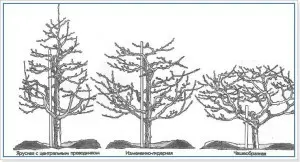
Spring pruning
Every gardener sooner or later wonders when it is better to cut an apricot. As practice has shown, preference should be given to spring or summer apricot pruning. So the tree will have enough time to prepare for wintering.
Spring pruning is carried out at the onset of warm, stable weather, before the start of sap flow, in March-April. Starting from the 2nd year after planting, one-year growth is shortened. With a rapid growth rate, more than 50-65 cm, of shoots continuing skeletal branches, they are shortened to half the length in strongly branching apricot varieties, and in weakly branching varieties – up to 2/3 of the length. For more information about spring pruning, see the video below.
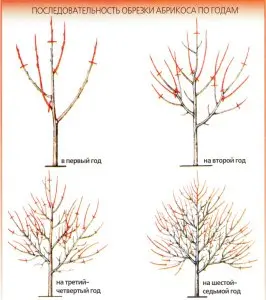
Summer pruning
A light summer apricot pruning or chasing, together with a preliminary pruning of adult branches in the spring, according to the scheme shown in the video, has a significant effect on fruiting. Pinching is carried out from mid-May to early June, but no later than the 4th-5th. As a rule, they pinch all the shoots of the current year, the length of which is more than 20-25 cm. 7-12 days after the summer minting, a young apricot develops a large number of young and 3-5 strong shoots, on which the future harvest is formed. Pruning at this time promotes active growth, and the apricot manages to restore the leaf surface completely, and flower buds develop on the growth of the second wave.
However, summer pruning will only be effective when the tree receives sufficient moisture, especially during dry, hot periods. It is impractical and harmful to carry it out on a garden plot with depleted soil and not provided with moisture. Such tweezing is carried out at least once every 2-3 years, making annual spring pruning in between.
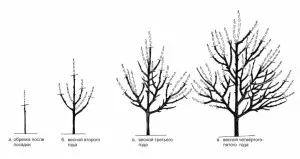
Apricot pruning scheme
Formation of a cupped crown
When forming such a crown, 2-4 branches are evenly placed at the apricot around the trunk through 2-4 buds. The conductor above the upper branch is removed. Above the upper side branch from the central conductor, a thorn of 15-20 cm without buds is left. Lateral branches are shortened by 4-7 buds. In this case, all sections should be performed on the external kidney. The sequence of operations in the formation of a cupped crown can be viewed on the video.
In the second year, in the spring, skeletal branches are cut at the same level to 45-55 cm. Then, in May or early June, chasing and removal of growth shoots and competitors on the trunk are sure to be carried out. After 45-55 cm, up to 3 branches of the second order are laid on the branches of the first order. Why choose from the left shoots 1-2, located on different sides of the main branch. In this case, the first branch of the second order on the trunk should be at a distance of 35-45 cm, and the second – 15-45 cm from the first. Do not shorten the conductors of the branches of the second and first orders. The remaining branches are removed to the ring, regardless of their location.
On the main branches of the first order, for the third year, they continue to lay the branches of the second order, and on those laid last year, they form the third. After that, unnecessary branches are removed for formation, growing inside the crown and vertically. In subsequent years, the apricot bears fruit, and from the age of 6-7, pruning for fruiting should be carried out. At the same time, 2-4 shoots are left at the ends of the branches, which are shortened by a third of the length. A replacement knot should be left between them. To do this, the most developed shoot is shortened to 8-15 cm. On the older wood, the fruit-bearing branches are shortened to the lower developed, strong shoot, which is also cut into 5-8 buds.
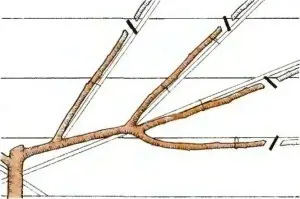
Tree Pruning Instructions
From the first year after planting, they begin to form a crown of the required shape. At a young age, the branches grow rapidly, but do not form a sufficient number of branches without pruning. A feature of the apricot is the fragile attachment to the central conductor of the branches, therefore, it is imperative to lay single branches with a large departure angle. Two branches are left on the seedling at a distance of 30-45 cm from each other. The branches located between them are bent and tied to the trunk. The central conductor is shortened by 25-30 cm, future skeletal branches – by half. In May, growths are removed on the stem and with an acute angle of discharge, and the remaining shoots are pinched over 5-8 leaves.
The following year, 1-3 more branches are left at least 35-45 cm higher than those chosen in the previous year. These branches are shortened according to the principle of subordination. The conductor is cut off, retreating from the last skeletal, shortened branch by 55-75 cm. The growths located at the ends of the two lower main branches are cut off depending on the degree of branching of the variety: for weakly branched by 2/3 of the length, for strongly branched by 1/2. Departing from the skeletal, branches of the second order are located on both sides of the trunk at a distance of 30-40 cm relative to each other. Small branches growing between them are removed. Last year’s growth is cut in half. When the shoots reach 6-8 cm in length, vertically growing competitive ones are removed, and in the second half of May they are minted.
The fifth main branch is formed for 3-4 years. The conductor above it should be removed, since it is desirable to have a compact, slightly branched tree on the site. One-year growth is cut off, and branches of the second order are laid on the middle branches, and branches of the third order are laid on the lowest ones. The next year, on the same branch, branches of the second order are formed, while the one-year growth is thinned out and shortened. Since shortening stimulates the growth of young shoots to the detriment of the fruit-bearing, over the next 2-4 years, only thinning is carried out, while removing broken, diseased, vertically directed and thickening branches. This completes the process of forming an apricot crown.
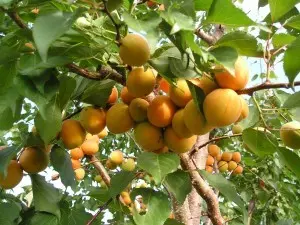
It is worth noting that the apricot bears fruit mainly on lateral shoots 25-30 cm long. The next year after shortening, an increase of 40-90 cm long is formed. If they are not pruned in the second year, they may bloom, but they will not bear fruit, and during the growing season they are covered with short 3-6 cm branches. In the third year, these branches actively bear fruit, but in 4-6 years they usually die off. In order for the yield to be high and regular, it is necessary to reproduce annually young fruit wood, for which 1-2 branches on each skeletal branch are shortened per three-year-old wood, leaving a short knot of 10-20 cm.
Video “Pruning an apricot and shaping its crown”
How to prune an apricot in the first years after planting, how to carry out cardinal rejuvenation for perennial, old wood, what pruning methods are used in modern horticulture, what apricot crown formation schemes are most effective for different varieties, during which period it is more productive to prune – all this is discussed in this video.









